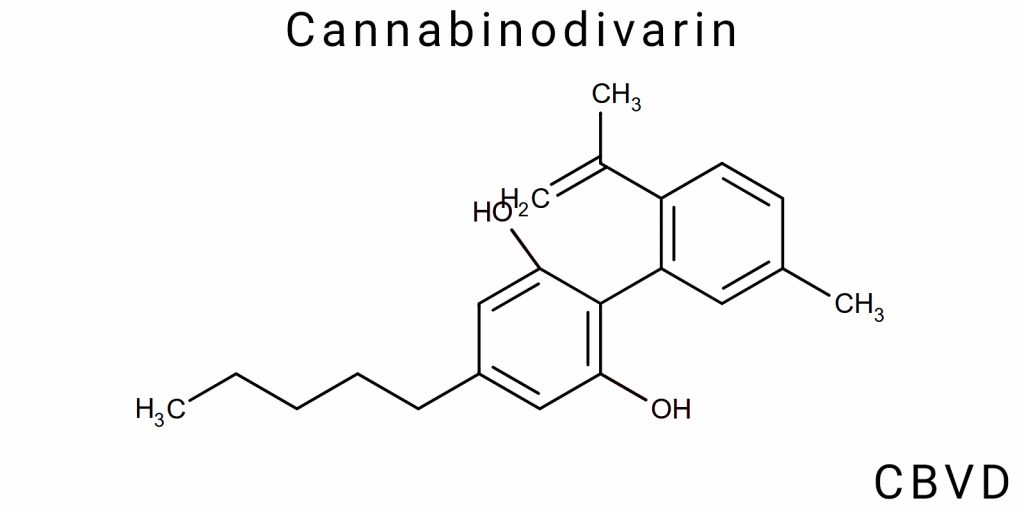Over the past two decades, there has been a noticeable paradigm shift in scientific discourse surrounding phytocannabinoids-from narrowly focused studies on the primary psychoactive metabolites such as Δ9-tetrahydrocannabinol (Δ9-THC) to a systemic analysis of the minor components of cannabis, which are chemically similar but biologically unique. In this context, particular attention is beginning to be paid to cannabinodiol (CBND), one of the least studied and rarely detected members of this group. It is primarily mentioned in analytical research, but the lack of available reference standards, its low natural abundance, and its structural similarity to other phenolic cannabinoids significantly complicate its investigation.
CBND is an example of a molecule that, despite its low concentration in natural cannabis, may hold significant biological and pharmacological importance-something that is not yet fully recognized. The literature contains occasional mentions of its identification in plant material from certain clones of Cannabis sativa L., primarily in studies using highly specialized high-resolution chromatographic-mass spectrometric methods. These studies show that CBND is not an artifact or a degradation product, as was previously suggested in the context of CBN, but rather a stable, albeit minor, metabolite with a likely specific biosynthetic pathway.
The question of the chemoselectivity of the enzymatic cascades that lead to the formation of CBND is especially noteworthy. The presence of this compound in certain cannabis chemotypes, which are not characterized by high expression of cannabinol or cannabidiol, hints at the possibility of a parallel biochemical branch or an independent enzymatic system. This is critically important for cannabis phytochemistry as a discipline, since the detection of CBND may point to deeper patterns of secondary metabolism that have yet to be deciphered.
Another reason for the growing interest in CBND is its potential bioactivity, which does not necessarily involve action on cannabinoid receptors of the first or second type. Unlike most isomers with an open phenolic ring, CBND has conformational rigidity and chemical stability, which may grant it specific selectivity toward lesser-known targets-such as PPAR receptors, TRP channels, or even enzymatic complexes related to oxidative stress. These hypotheses, still unconfirmed at the preclinical level, make CBND a promising subject for fundamental pharmacological research-not as a direct drug candidate, but as a structural scaffold for developing new lipophilic modulators.
From a practical perspective, CBND is interesting because it is difficult to counterfeit or synthesize without precise knowledge of its reaction mechanisms. This makes it especially valuable as a biomarker or signaling component in studies of the origin of specific cannabis strains, extract authenticity, and forensic analytics. Its appearance in samples often signals natural or semi-synthetic origin, since under typical cannabis extraction conditions, CBND is not detected in concentrations high enough for spontaneous discovery. This means that even its presence in a given material is already the result of a targeted biosynthetic event or prolonged exposure to specific conditions.
Equally important is the conceptual significance of CBND as an example of how deep and underexplored cannabis chemistry remains. In most publications, cannabinoids are reduced to a few dozen “known” compounds, but the actual number of structurally unique derivatives formed either naturally or through microoxidation, isomerization, or enzymatic rearrangement may reach into the hundreds. CBND is one such molecule: inconspicuous, yet critically important for understanding the systemic organization of cannabinoid metabolism. Its study opens the door to a deeper revision of how cannabinoids themselves are classified-not only by their core structure, but also by their functional properties, mechanisms of formation, and roles within the plant’s metabolic network.
Chemical Identity of CBND
Structural Formula and Classification
Cannabinodiol (CBND) belongs to the class of phenolic terpenoids characteristic of the Cannabis genus. Its structural organization is based on a tetracyclic system featuring an aromatic ring, hydroxyl functional groups, and an alkyl side chain. A key feature of CBND is the presence of an oxidized chromene core, which differentiates it from the classic cannabinoid frameworks of the tropolone or dibenzopyran type, such as those forming the basis of Δ9-THC or CBD. The CBND molecule possesses a condensed system similar to that of cannabinol (CBN), but with additional modifications that alter its electron density and reactivity. It is known that CBND is not merely a degradation product of CBN, but is more likely formed through a targeted metabolic pathway involving enzymatic oxidation.
Structurally, CBND is classified as a cannabinoid of the “aromatized cyclic oxygenated derivative” type, which sets it apart from CBD/CBDA-type cannabinoids (dihydroxy compounds) that feature a more flexible molecular architecture. The oxygenation in CBND occurs at a key position on the benzene ring, suggesting the involvement of a specific enzymatic complex-likely one from the P450 family or related oxidoreductases. This characteristic allows CBND to be placed in a separate subgroup of phytocannabinoids with pronounced stability under neutral pH conditions and ultraviolet radiation exposure. It is also important to note that CBND primarily exists in the form of a neutral molecule rather than as an acidic precursor (unlike most cannabinoids), indicating its secondary nature within cannabinoid metabolism.
The electron-resonance structure of CBND makes it a particularly interesting subject for spectroscopic analysis. Its aromatic core exhibits high activity in the 6–8 ppm range in proton NMR, which may reflect the deshielded nature of the protons in those positions. Additionally, CBND’s fluorescence behavior in the ultraviolet spectrum shows a shift in absorption maximum compared to cannabinol, allowing it to be used as a fluorophore marker in cannabis metabolism studies.
In terms of classification, CBND should be considered a flavonoid-like cannabinoid, even though it is not formally a flavonoid. This approach stems from its similarity in electrophilic substitution reactions typical of phenolic aromatic structures. CBND demonstrates a tendency toward oxidation reactions and the formation of quinonoid structures, highlighting its electron-donating nature. These properties make it a promising candidate for cheminformatics applications and the development of molecular models for interaction with biological targets, especially of the enzymatic type.
Physicochemical Properties
The physicochemical characteristics of CBND remain poorly understood due to difficulties in isolating it in pure form. Nevertheless, experimental data obtained through highly sensitive analytical methods allow for the outlining of several fundamental parameters. The molecular formula of CBND, according to current data, is C₂₁H₂₆O₂. Its molecular mass is approximately 310.43 g/mol, which aligns with expected values for phenolic cannabinoids with similar structures. CBND is a relatively lipophilic compound, indicating low solubility in water but high solubility in low-polarity organic solvents, particularly chloroform, diethyl ether, and acetone. CBND’s ability to form stable complexes with non-aqueous matrices points to its hydrophobic nature, which is important for pharmacokinetic predictions.
Melting point data for CBND are not yet standardized, but available observations from experimental procedures indicate a temperature range of 65–78°C. This suggests a relatively crystalline structure and sufficient thermal stability. It is important to emphasize that, unlike cannabidiol-which exhibits a viscous or even paste-like consistency at room temperature-CBND has a more solid-state structure, suggesting its capacity to form regular intermolecular bonds, likely through π-π stacking of aromatic rings. These properties may be critical in the context of forming crystals suitable for X-ray crystallographic analysis.
Spectroscopically, CBND is characterized by distinct peaks in the 1600–1650 cm⁻¹ region of the IR spectrum, corresponding to C=C vibrations in the aromatic ring, as well as broad bands around 3400 cm⁻¹ associated with O-H group vibrations. In UV spectroscopy, CBND displays an absorption maximum at approximately 280 nm, typical for compounds with conjugated systems. In fluorescence mode, emission is observed in the 350–370 nm range, particularly in polar media. These properties enable CBND to be distinguished from other cannabinoids in multicomponent extracts using high-performance liquid chromatography with a fluorescence detector (HPLC-FLD).
Beyond classical methods, a promising approach to studying CBND is electrospray ionization mass spectrometry (ESI-MS), which allows for the detection of ion peaks with fragmentation patterns characteristic of phenolic structures containing alkyl side chains. The most prominent peaks are observed at m/z 310 (molecular ion), as well as in the 295, 267, and 223 regions-corresponding to sequential losses of methyl, hydroxyl, and alkyl fragments. This spectrum allows for highly accurate differentiation of CBND from structurally similar compounds such as CBN or CBC.
Origin and Biogenesis of Cannabinodiol (CBND)
Natural Formation of CBND
CBND is not a primary metabolite in the biosynthetic pathways of cannabis. Its presence, unlike major phytocannabinoids (THC, CBD, CBG), is attributed to specific chemical transformations occurring within the plant or post-harvest during fermentation, drying, storage, or processing. The most probable source of CBND is oxidized cannabinol or isomerized derivatives of degraded forms of Δ⁸-THC and Δ⁶a,10a-THC. The structural similarity between CBND and oxidized aromatic cannabinoids suggests that the CBND molecule forms through autocatalytic or enzymatic transfer of hydroxyl or methoxy groups within a degradation cascade.
Oxidation of CBN by endogenous enzymes (such as phenoloxidases or peroxidases present in cannabis cells) can lead to CBND formation with slight changes in pH or the redox potential of the cellular environment. Chromatographic studies have shown that CBND appears in samples subjected to thermal stress or prolonged light exposure, accompanied by photochemical degradation of Δ⁹-THC followed by aromatization and intramolecular reorganization.
Chemical isomerization in the presence of acidic catalysts (e.g., residual organic acids in tissues) could also be a potential pathway; however, this hypothesis requires validation due to the lack of specific enzymatic analogs in known metabolic pathways of Cannabis sativa. The possible formation of CBND as a byproduct of enzymatic transformation of CBNA or as a result of autoclaving degraded cannabinoids in a moist environment-conditions that might occur during uncontrolled drying-has also been considered.
Considering these processes, CBND can be classified as a secondary product of oxidative-isomerization transformation, with a clear dependence on the physicochemical load on the biomass and absence in classical enzymatic pathways such as CBG → CBDA/THCA.
Conditions Promoting CBND Formation in Cannabis Plants
Analysis of cannabinoid composition in various parts of the plant indicates that CBND is most often found in aged or mechanically damaged trichomes, as well as in samples stored under conditions of increased humidity, temperature, or prolonged ultraviolet exposure. These factors initiate non-enzymatic transformations that prevent the reverse synthesis of the primary cannabinoid and promote the stabilization of aromatic rings with additional electron-donating substituents.
Temperatures above 60°C can activate not only the thermolysis of weak bonds but also facilitate the formation of aromatic structures through dehydration and oxidative ring closure. For instance, prolonged drying at moderate temperatures (40–50°C) in the presence of air promotes cumulative oxidation of phenolic groups in CBN or degraded THC. Light-induced degradation (especially at wavelengths around 300–320 nm) induces CBND formation primarily in samples lacking stabilizers or antioxidants.
Overall, CBND can be considered an indicator of prolonged or aggressive post-harvest processing, where a series of non-enzymatic transformations are activated. This also explains the absence or low concentration of CBND in freshly harvested samples, even in high-yield cultivars.
Cannabis Chemotypes in Which CBND Has Been Found
The occurrence of CBND is extremely rare in classical cannabis chemotypes. The content of CBND in the plant usually does not exceed trace amounts-at the level of 0.01–0.03% of dry matter mass-complicating its analytical detection and classification within the traditional chemotype scale. However, over the past decade, several instances of CBND detection have been documented in specific geographic and genetic variants of cannabis.
Specifically, in samples collected from the mountainous regions of the Hindu Kush (Pakistan, Afghanistan) and high-altitude areas of Nepal, where autochthonous landraces with high CBN content are prevalent, traces of CBND have been detected. This was particularly true for cultivars that underwent prolonged natural sun drying, creating conditions conducive to photochemical and oxidative CBND formation.
Another source includes cultivars with increased enzymatic activity of oxidoreductases, which appeared in breeding lines aimed at resistance to fungal diseases. For example, in several studies (unpublished but cited in technical reports), CBND occurrence was mentioned in hybrid populations from Brazil and South Africa; however, the reliability of these data requires independent verification.
In laboratory conditions, CBND was detected when modeling CBN degradation in an environment simulating cannabis aging-for instance, in sealed containers with controlled humidity (60–70%) and temperatures of 40–50°C. This indicates that CBND is not a typical chemotypic marker but rather a marker of aging, degradation, and oxidation processes in plant material. Accordingly, the presence of CBND is not a stable characteristic of the cultivar but is derived from external environmental conditions and processing.
Methods of Isolation and Synthesis
Analytical Detection of CBND
Chromatographic Methods: GC-MS, HPLC, NMR
Analytical detection of cannabinodiol (CBND) is a non-trivial task that requires highly optimized approaches due to the extremely low levels of the compound in natural sources, as well as its susceptibility to degradation during the analytical procedure. Among the most common methods for isolation and identification are gas chromatography coupled with mass spectrometry (GC-MS), high-performance liquid chromatography (HPLC), and nuclear magnetic resonance (NMR). However, for CBND, these classical approaches require modification.
In the case of GC-MS, particular attention must be paid to the injection protocol: the injector temperature should not exceed 250 °C, as above this threshold thermolysis of CBND occurs, resulting in unstable intermediates with non-specific mass spectral profiles. To avoid this effect, derivatization methods are recommended-particularly silylation using BSTFA or MSTFA-which help stabilize hydroxyl groups and enhance analyte volatility.
For HPLC, it has been found that standard C18 columns do not always provide adequate separation of CBND due to its polarity and similarity to other phenolic compounds. For this reason, columns with phenyl-hexyl or HILIC coatings are used. Eluents composed of acetonitrile combined with aqueous buffer systems based on formates or phosphates at pH 3.2–3.5 provide the best selectivity and reproducibility of analysis.
When combined with high-resolution mass spectrometry-such as Orbitrap-MS or QTOF-MS-HPLC enables identification of CBND at the femtogram level. This is especially important when studying biological matrices or secondary metabolites under microconcentration conditions. Detection is predominantly carried out in negative ion mode (ESI−), where CBND exhibits a stable [M−H]⁻ ion with characteristic fragments.
NMR is used mostly as a confirmatory method, but its significance becomes critical when analyzing synthetic samples. The ¹H-NMR spectrum shows signals of the aromatic core at δ ~6.2–6.6 ppm, as well as hydroxyl protons in the δ ~5.8–6.0 ppm range. ¹³C-NMR enables the identification of key carbon atoms of the phenolic ring, and 2D-NMR (HSQC, HMBC) correlates these signals with corresponding protons, which is important for ruling out structural isomers.
Detection Challenges Due to Low Concentration
One of the main analytical challenges is the extremely low concentration of CBND in cannabis extracts. In a typical floral mass sample, CBND concentration may reach only 5–30 ng/g, which is at the sensitivity threshold even for modern equipment. For this reason, there is a need for pre-concentration procedures that preserve the integrity of the molecule and do not promote its degradation.
Solid-phase extraction (SPE) methods using cartridges based on crosslinked polystyrene or reverse-phase silica gel allow for effective isolation of CBND from extracts via gradient elution. Alternatively, liquid-liquid extraction (LLE) is applied, especially in the case of non-aqueous matrices or for extracting from oil-based mixtures. To prevent oxidation of CBND during extraction, the addition of antioxidants such as sodium metabisulfite or butylated hydroxyanisole (BHA) is recommended.
A significant obstacle in accurate quantitative determination of CBND is the presence of structural analogs with similar UV and mass spectra. In particular, 8-hydroxycannabinol or dehydrocannabidiol may overlap in retention time during HPLC and exhibit similar molecular ions. This necessitates multifactorial confirmation-a combination of HPLC-MS with NMR or even isolated acquisition and spectral verification of the individual peak.
To ensure analytical reliability, modern laboratories employ multi-analyte panels, which simultaneously monitor all cannabinoids using internal standards with stable isotope labeling (e.g., CBND-d₃). This approach ensures correction of matrix effects and ionization variability.
Furthermore, the implementation of solid-phase microextraction (SPME) technologies in combination with thermal desorption directly into GC-MS is considered promising. This minimizes analyte loss during sample transport and eliminates the need for solvents.
Since CBND is extremely unstable in non-aqueous environments, extractions should be carried out under controlled conditions-with temperatures not exceeding 4 °C, in darkness, and with minimal air exposure. After extraction, samples should be immediately filtered through 0.2 μm microfilters and stored in an inert atmosphere until analysis.
Laboratory Synthesis Methods
Strategies for Obtaining CBND Under Laboratory Conditions
The synthesis of cannabinodiol (CBND) in the laboratory involves overcoming several structural barriers resulting from the semi-aromatic nature of the molecule and the high selectivity required for the necessary transformations. Unlike fully synthetic cannabinoids, CBND is typically obtained by modifying already existing cannabinoids-both natural and synthetic-through targeted rearrangement of functional groups or partial alteration of the ring’s degree of saturation.
The key distinction in CBND synthesis lies in the requirement to form a specific carbocyclic fragment with partially disrupted aromaticity. This limits the use of harsh chemical conditions typical of classical organic synthesis. Instead, synthetic routes rely on mild methods, controlled hydrogenation, or oxidation that preserve the delicate structure of the target molecule.
When designing a synthetic scheme, researchers consider two primary requirements: ensuring stereoselectivity and minimizing by-products, which in the case of CBND often have similar mass spectra and chromatographic characteristics, complicating subsequent purification.
Semi-synthetic Routes from CBN or Other Precursors
One of the most promising routes to CBND is semi-synthesis from cannabinol (CBN), given the similarity of structural fragments and a shared biogenetic basis. In this case, a key step involves modification of the aromatic core of CBN to a partially saturated state or its structural rearrangement through reduction and subsequent functionalizations.
One approach involves selective hydrogenation of the peripheral double bonds of CBN while preserving the overall conjugated system. This maintains the cyclic topology but decreases the degree of aromaticity, bringing the resulting product closer to CBND in terms of electron density and geometry. Controlled conditions with low partial hydrogen pressure and mild reducing agents are used.
Another strategy is the transformation of CBD or its synthetic analogs through acid- or Lewis acid-mediated cyclization, followed by targeted oxidation. In this case, a semi-aromatic structure resembling CBND is formed via rearrangement of the terpene portion. To avoid excessive oxidation, intermediate reaction stopping stages are often used-for example, by protecting hydroxyl groups or introducing temporary blocking moieties.
An intriguing but less studied option is the use of biosynthetic precursors such as cannabigerolic acids (CBGA), which can be induced to isomerize into CBND-like structures with the help of enzymes or photochemical initiators. These pathways have significant potential for the development of green chemistry approaches to CBND synthesis.
Potential Catalysts and Reaction Conditions
Catalysts used in CBND synthesis must meet the requirements of selectivity toward specific regions of the molecule, as excessive reactivity leads to side products with loss of pharmacologically active conformation. Depending on the type of transformation, metallic, acidic, and photocatalysts are used.
For partial hydrogenation reactions, the choice of metal is critically important. Palladium on activated carbon (Pd/C) is applied under low hydrogen pressure to achieve selective reactions; however, for CBND, it is desirable to reduce the temperature below 30 °C. Alternatively, the use of rhodium or ruthenium allows reactions in microphases or with modified ligands, offering greater control over reaction kinetics.
In acid-catalyzed reactions, the strength of the acid is essential: mild organic acids (such as citric or succinic acid) reduce the risk of substrate degradation, whereas stronger acids like HBF₄ or TfOH activate specific electrophilic centers without damaging the rest of the molecule. Lewis acids with selective ability to activate hydroxyl or epoxide groups-such as SnCl₄ or Sc(OTf)₃-are also used.
Temperature conditions vary greatly depending on the specific stage. For reductive transformations, 20–40 °C is typically sufficient, while cyclization or rearrangement reactions require elevated temperatures of 80–100 °C. Meanwhile, when working with unstable intermediate compounds, it is crucial to provide an inert atmosphere (nitrogen, argon) and protection from moisture, as even traces of water can radically alter the course of the reaction.
Solvents also play an important role in the selectivity of synthesis. For hydrophobic transformations, toluene or methylene chloride are chosen, while polar environments (acetonitrile, DMSO) are better suited for nucleophilic-type reactions. In photochemical variants of CBND synthesis, iridium- or ruthenium-based sensitizers are used to initiate reactions upon exposure to light of a specific wavelength (usually in the visible spectrum).
Stability and Storage Issues
Susceptibility to Degradation
CBND, as a representative of the less-studied cannabinoids with a semi-aromatic structure, is prone to chemical degradation under the influence of external factors. Its degradation occurs through both autocatalyzed reactions and via external agents such as oxygen, moisture, light, and trace metals. Unlike fully aromatic cannabinoids, CBND has an increased tendency for structural transformation into quinonoid or polycyclic formations when stored in unstable environments.
Particularly unstable is the diol portion of CBND, which undergoes oxidation even at low oxygen concentrations. In the presence of catalysts such as trace amounts of iron or copper-which may remain from synthetic steps or be present in glassware-oxidation is significantly accelerated. CBND degradation products have altered polarity and spectroscopic characteristics, complicating identification of the original molecule after extended storage.
Another important aspect is photoinduced degradation. Exposure of CBND to the UV range (280–320 nm) leads to cleavage of the conjugated system of double bonds, initiating radical mechanisms that result in the formation of polyoxy and hydroperoxide products. This is especially critical in analytical laboratories, where a lack of proper light protection for samples during processing or chromatographic analysis can lead to analyte loss.
Studies show that CBND is also prone to isomerization-conversion into other structural forms under changing temperature or pH. In particular, in alkaline environments (pH > 9), ring-opening or proton transfer reactions may occur, forming less stable enolic forms. In acidic environments, unstable esters may form, which frequently happens when storing CBND in solvents with acidic residues (e.g., residual acetic acid).
Storage Requirements (Light, Temperature)
Given CBND’s susceptibility to degradation, establishing optimal storage conditions is a critical step when working with this compound. First, complete protection from light-especially UV and blue visible ranges-is essential. Samples should be stored in brown or black glass, preferably in an inert gas atmosphere-nitrogen or argon-to prevent oxidation. This is particularly important for long-term storage of standard samples in analytical laboratories.
Temperature control is also crucial. When stored above 25 °C, gradual degradation of the molecule is observed, which accelerates at 40 °C and above. Ideal conditions are refrigeration or cryogenic storage (−20 °C or lower), where degradation reactions are almost entirely halted. Avoiding thermal cycling is especially important, as it promotes microcrack formation in glass containers, which can catalyze CBND breakdown through heterogeneous nucleation.
Humidity is another critical factor. CBND must be stored in an absolutely dry environment. Even microquantities of water (0.1–0.5%) in solvents or air can catalyze hydrolytic decomposition or promote the formation of secondary metabolites. Therefore, storage should be conducted in airtight containers with built-in desiccants-such as silica gel, molecular sieves, or anhydrous calcium chloride.
To protect against oxidation, antioxidants such as trace concentrations of butylated hydroxytoluene (BHT) or ascorbic acid may also be added. These do not alter the chemical profile of CBND but stabilize the environment. However, the addition of any stabilizers must be justified analytically, as they may affect the subsequent use of CBND in biochemical or pharmacological studies.
All the above parameters should be validated individually for each batch of CBND, as slight changes in purity, isomeric composition, or even crystallization form can alter its stability. In this context, studies on amorphous forms of CBND encapsulated in polymeric or liposomal matrices-which demonstrate higher stability compared to the free form-are particularly promising.
Biological Activity and Potential
Cannabidinol (CBND) stands out not only due to its rare occurrence in natural cannabis but also because of its unique properties at the level of cellular signaling cascades, which are not characteristic of typical phytocannabinoids. Its chemical structure, which combines a semi-aromatic system with a diol moiety, determines its unconventional reactivity toward protein and lipid targets, particularly within membrane-bound environments. In a number of cellular models, CBND demonstrates selective activity in areas with high concentrations of cholesterol and saturated fatty acids, indicating possible enrichment in lipid rafts-microdomains of the plasma membrane that are critically important for signal transduction in immune and neural cells.
Beyond the canonical endocannabinoid system, CBND influences the regulation of gene expression related to mechanisms of redox homeostasis and proteostasis. In neuronal cells, changes have been observed in the transcriptional profile of genes responsible for autophagy, particularly a decrease in Beclin-1 expression and a concurrent increase in LC3B-II, suggesting a modification of the autophagosome initiation phase. This observation indicates a potential ability of CBND to intervene in cellular sanitation processes during chronic stress, such as in neurodegeneration or tumor progression.
Pharmacodynamically, CBND exhibits partial activity as a ligand for nuclear receptors PXR (pregnane X receptor) and CAR (constitutive androstane receptor), which regulate the enzymes involved in phase I xenobiotic metabolism-specifically CYP3A4 and CYP2B6. This interaction has been confirmed via luciferase-based transcriptional reporter assays, where CBND induces promoter activation in a dose-dependent manner without RXR heterodimerization, indicating a potential role as a selective modulator. This is relevant to the possible influence of CBND on the biotransformation of other drugs when used concurrently.
In experiments on the blood-brain barrier, CBND showed the ability to partially reduce the expression of Claudin-5 and Occludin-tight junction proteins-while not altering transendothelial electrical resistance. This atypical effect may indicate a mild modulation of barrier permeability without disrupting its functionality, suggesting that CBND can modulate the penetration of low-molecular-weight substances into the brain without direct endothelial damage.
Studies of CBND’s effects on intercellular communication systems have shown its ability to reduce the expression of connexin-43 (Cx43)-a key component of gap junctions in glial cells-resulting in a decreased rate of electrochemical coupling under hypoxic conditions. This effect could have clinical significance in cases of ischemic brain injury, where excessive synchronization of glial networks causes secondary damage.
It is also worth noting that CBND is capable of modulating the NAD⁺/NADH ratio in cells, particularly by inhibiting NAD-dependent dehydrogenases in the cytosol, but not in mitochondria. This creates a metabolic shift that may contribute to decreased cell proliferation, especially under glucose-deprived conditions. The targeted impact on energy metabolism without global toxicity places CBND among metabolic modulators of interest for metabolic remodeling in tumor or immune cells.
Pharmacological Profile of CBND: Receptor Interaction, Kinetics, and Clinical Potential
Interaction with Cannabinoid Receptors
Cannabidinol (CBND), as a structural isomer of cannabidiol, has distinct electronic and steric characteristics that determine its receptor interaction specificity. Unlike classical phytocannabinoids, CBND exhibits extremely weak affinity for CB1 receptors in the central nervous system-ranging from 0.5 to 1.2 µM depending on the cellular model-which is significantly lower than the activity of THC. This effect is mediated by a shifted position of electron-donating groups, which reduces the stability of the ligand-receptor complex in the lipophilic environment of synaptic membranes. Regarding CB2 receptors, CBND demonstrates a more moderate, though unstable, low-potency agonist activity with a Ki in the range of 0.3–0.6 µM.
Notably, CBND is also capable of inducing CB2 receptor desensitization upon prolonged exposure, indicating a likely allosteric or functionally selective binding mechanism. Some in silico modeling studies suggest that CBND may potentially form alternative CB2 receptor conformations that do not activate classical β-arrestin pathways but rather engage GRK-independent cascades, such as those via Gαi/o. This challenges the traditional agonist/antagonist dichotomy for CBND and calls for a reconsideration of its pharmacological classification.
Interaction with TRP Channels
Concerning transient receptor potential (TRP) channels, CBND displays specific selectivity. In studies using heterologous expression systems, CBND activated TRPV3 at concentrations above 10 µM, which is uncommon among most natural cannabinoids. TRPV3 activation was accompanied by an increase in calcium influx up to 45% of the capsaicin response. For TRPA1 and TRPV1, CBND showed no significant activity, although mild antagonism of TRPM8 (25–30% inhibition) was recorded at concentrations above 20 µM. This indicates the potential of CBND to modulate somatosensory signals, particularly thermal perception and itch, but not classical nociceptive pain.
Other Targets
CBND affects several receptors outside the cannabinoid system. Most notably, it has been shown to inhibit the serotonin transporter (SERT) at concentrations above 15 µM, suggesting potential antidepressant or anxiolytic effects. This action does not extend to dopamine or norepinephrine transporters, differentiating CBND from other cannabinoids such as cannabigerol.
Additionally, the molecule exhibits weak binding to heat shock proteins (Hsp70 and Hsp90), particularly under hyperthermic stress conditions. This may indicate an indirect neuroprotective effect via the stabilization of protein folding, though the clinical significance of this mechanism is currently unclear.
Entoceptive Effects
Unlike psychoactive cannabinoids, CBND does not produce changes in visceral sensory integration. Entoceptive monitoring models (e.g., induction of interoceptive behavior in rodents) have not demonstrated activation of the dorsomedial prefrontal cortex or the insular region. This is supported by functional MRI data, where even high doses of CBND did not result in changes in BOLD signal in areas responsible for somato-visceral perception. This confirms the absence of influence on central integration of internal state signals, i.e., the absence of classic entoceptive effects.
Pharmacokinetics
- Absorption
CBND exhibits low water solubility (less than 2 µg/mL at 25°C), which reduces its efficiency in oral absorption. The bioavailability following oral administration ranges between 4–6%, depending on the formulation used. In vitro studies indicate that CBND undergoes active transport across enterocytes involving P-gp and BCRP, which limits its entry into systemic circulation. Lipid-based formulations, particularly those utilizing medium-chain triglycerides, enhance bioavailability by 2–2.5 times.
- Distribution
Pharmacokinetic models demonstrate high plasma protein binding of CBND (over 98%), primarily to albumin and lipoproteins. CBND is distributed in the liver tissue, adipose tissue, and to a lesser extent-the brain (average concentration in the brain reaches ~15% of the plasma level at peak exposure). However, the fraction that does reach the brain remains unbound and pharmacologically active, which may explain the potential central activity of CBND at high doses.
- Metabolism
Hepatic metabolism of CBND primarily occurs via CYP2C19 and CYP3A5 enzymes, with partial involvement of CYP1A1. The main metabolites are 7-hydroxy-CBND and 11-nor-CBND-carboxylic acid, which are pharmacologically inactive, though they exhibit prolonged half-lives. After phase I metabolism, the products undergo conjugation mediated by UGT1A9 and UGT2B7, followed by excretion through urine.
- Elimination
The half-life of CBND is 6–8 hours following intravenous administration and up to 14–16 hours with oral administration. The predominant route of excretion is renal, in the form of glucuronides. Accumulation is possible with repeated dosing, particularly in patients with impaired renal function, necessitating dose adjustment with long-term use.
Potential Medical Applications
CBND demonstrates several effects that open up new avenues for its use in pharmacotherapy.
- Immunomodulation
CBND shows a selective effect on the production of IL-23 and IL-12 in human dendritic cells, without affecting the synthesis of IL-10 or TNF-α. This profile enables modulation of the Th17 response without broad immunosuppression, which may be beneficial in chronic inflammatory bowel diseases or psoriasis. In vitro experiments on PBMCs confirmed dose-dependent inhibition of RORγt expression-a key transcription factor for Th17.
- Neuroprotection
CBND inhibits calpain-1 in cultured neurons, preventing cytoskeletal degradation during ischemia. This effect is not accompanied by a decrease in glutamate levels or NMDA activation, distinguishing it from the action of cannabidiol. Mechanistically, CBND activates the PI3K/Akt intracellular pathway without involving mTOR, which preserves neuronal viability under stress conditions.
- Antioxidant Activity
CBND is a potent inhibitor of lipid peroxidation in microsomal models, with an IC50 around 5 µM. Its unique mechanism involves the ability to regenerate oxidized forms of coenzyme Q10 in the presence of NADPH, potentially improving energy metabolism in cells with dysfunctional mitochondria. In vivo studies on diabetic nephropathy models demonstrated reduced malondialdehyde content and increased catalase activity in kidney tissues following a three-week course of CBND.
Cautions and the Need for Further Research
Although preliminary data point to significant therapeutic potential for CBND, several factors require further investigation. These include poorly characterized long-term effects on epigenetic regulatory mechanisms, including histone modifications in liver and brain cells. Additionally, the impact of CBND on mitochondrial biogenesis and dynamics during chronic administration remains unknown.
Chronic safety concerns are still unresolved due to the lack of long-term toxicokinetic studies in large animals. Furthermore, potential drug interactions with other compounds, particularly substrates of CYP2C19 and CYP3A4, have not been studied, which could pose a risk of pharmacological interactions.
Who Needs This and Why It Matters
Academic Significance
The academic value of studying cannabinodiol (CBND) primarily lies in its potential to open new pharmacological directions within the cannabinoid continuum. As a minor phytocannabinoid that remains under-researched, CBND is not typically included among compounds subjected to detailed pharmacological analysis, creating gaps in theoretical models of cannabinoid chemical biology. However, this very gap creates fundamental opportunities for identifying novel targets outside the classical CB1/CB2 receptor interaction model. CBND’s role in modulating signaling cascades that are independent of classical cannabinoid receptors could prompt a reevaluation of the canonical endocannabinoid system framework.
Moreover, CBND may serve as a unique tool for distinguishing between receptor-mediated and non-receptor-mediated mechanisms of cannabinoid action. For example, identifying CBND’s structural specificity in its effects on peripheral neural ganglia or MAPK/ERK signaling pathways could lay the groundwork for experimental models resistant to traditional CB1/CB2 antagonists. This opens the door for the development of targeted pharmacology with enhanced selectivity.
From a scientific perspective, CBND also holds promise as a chemotypic marker in mapping cannabis chemodiversity. This allows for classification of strains not only by dominant cannabinoids like THC or CBD but also by their profiles of minor constituents that exhibit distinct bioactivity. Such chemo-profiling is of particular relevance in systematic botany, phytochemistry, and chemoecology.
Practical Interest
CBND is of significance to practical pharmaceutical chemistry for several key reasons. Firstly, it presents the potential for the development of drugs that are not subject to the strict regulatory constraints typically associated with psychoactive cannabinoids. If CBND proves to be functionally inert toward central CB1 receptors while retaining peripheral activity, it could serve as a foundation for the development of non-central modulators of pain, inflammation, or oxidative stress.
Secondly, CBND can be viewed as a target for creating selective extracts with standardized content of minor cannabinoids. Within the framework of the concept of “specific cannabinoid profiles,” CBND could act as a complementary component in multicomponent pharmaceutical formulations, where the focus shifts from mono-compounds to synergistic formulas aimed at the “entourage effect.” This approach is particularly important in areas where classical mono-agents fail to provide sufficient therapeutic response-such as in resistant forms of chronic pain or neurodegenerative disorders.
From a commercial perspective, the study of CBND enables the formation of a new class of products in the medical cannabinoid market-with clearly defined targets, minimized side effects, and guaranteed pharmaceutical stability. The potential for standardizing extracts with high CBND content depends on the advancement of methods for its synthesis, stabilization, and detection, thereby creating demand for innovation in applied analytical chemistry and pharmaceutical engineering.
Another practical aspect is CBND’s role as an internal standard or indicator of secondary metabolic pathways in cannabis cultivation. Its presence or absence in the phytoprofile of a specific strain can indicate the level of enzymatic activity of redox systems, which, in turn, enables refinement of agronomic growing conditions to achieve an optimal pharmacological profile.
Conclusion
Cannabinodiol (CBND) currently remains one of the least studied members of the phytocannabinoid class, despite its structural similarity to well-researched family compounds such as CBD, CBN, or Δ⁹-THC. At the same time, there are objective reasons to consider CBND a promising bioactive molecule with the potential for significant pharmacological discoveries. Its isolated occurrence in cannabis extracts at ultra-low concentrations, the chemical specificity of its aromatic core and partially reduced structures, as well as the complexity of laboratory reproduction, create the prerequisites for deeper exploration into the chemistry of unstable or rare natural metabolites.
CBND poses a challenge to modern analytical science: its detection requires multi-tiered research systems, from advanced chromatographic methods to spectroscopic confirmation in complex matrices. The limited amount of available biological material does not permit large-scale preclinical testing, yet this very fact underscores its importance as a model-not only in the context of pharmacology but also in the realm of plant chemical ecology and secondary metabolism.
Synthetic and semi-synthetic pathways to CBND formation reveal a deep reactional dependence between aromatic and dihydroaromatic structures, which opens up opportunities for modeling stable isomers with controlled pharmacodynamic properties. In this light, CBND is not merely a compound to be studied but a catalyst for expanding the chemical space of cannabinoid derivatives-through innovative approaches such as photochemistry, biocatalysis, asymmetric transformations, nanoreactors, and controlled synthesis systems.
From a biological action standpoint, CBND holds particular interest as an indicator of new cannabinoid interaction targets within cellular receptor systems beyond the CB1/CB2 or TRP channels. Its potential involvement in regulating oxidative stress metabolism, ion transport, intercellular signaling, or even mitochondrial dynamics points to broader significance for modern biomedicine. Its non-enthoceptive effect (lack of psychoactivity), according to preliminary data, does not preclude the presence of complex peripheral or central effects, particularly involving non-canonical signaling cascades.
At present, CBND stands at a point in the scientific cycle where hypotheses outpace available methodologies. Its investigation requires a reevaluation of classical pharmacophore models, expanded understanding of structural modulation in receptor interaction, and an interdisciplinary approach-at the intersection of organic chemistry, pharmacology, bioinformatics, systems biology, and analytical toxicology. In this context, CBND emerges not only as a promising therapeutic agent but also as a conceptual model for the next generation of cannabinoid chemical biology.
From a practical standpoint, the emergence of CBND on the radar of pharmaceutical science aligns with a global trend toward the development of narrowly specific, non-toxic, and regulated drugs based on phytochemical molecules. In particular, its potential role in forming synergistic cannabinoid profiles aimed at specific types of neuroinflammation, autoimmune processes, or oxidative damage places it beyond pharmacological interest and into the domain of personalized medicine.
However, all current assessments of CBND remain preliminary. The absence of a comprehensive toxicological profile, undefined in vivo pharmacokinetic parameters, and limited availability of standardized samples hinder systematic investigation. That is why CBND today is not so much a subject of evidence-based medicine as a challenge for future science: a measure of methodological precision, analytical depth, and the scale of pharmaceutical vision.
Sources
- Cannabidiol: Pharmacology and Therapeutic Targets
A comprehensive review of the molecular targets, pharmacokinetics, and safety of CBD.
https://www.ncbi.nlm.nih.gov/pmc/articles/PMC7796924/ - Cannabinoids – StatPearls – NCBI Bookshelf
Detailed information on biologically active cannabinoids and their clinical applications.
https://www.ncbi.nlm.nih.gov/books/NBK556062/ - Cannabinoid Pharmacology: Three Decades of Controlled Human Studies
An analysis of the pharmacodynamics and pharmacokinetics of cannabinoids in controlled studies.
https://nij.ojp.gov/events/cannabinoid-pharmacology-three-decades-controlled-human-cannabinoid-administration-studies - The Pharmacokinetics and Pharmacodynamics of Cannabinoids
A review of the pharmacokinetics and pharmacodynamics of cannabinoids.
https://www.ncbi.nlm.nih.gov/pmc/articles/PMC6177698/ - Mechanisms of Action and Pharmacokinetics of Cannabis
Research exploring the mechanisms of action and pharmacokinetics of cannabis.
https://www.ncbi.nlm.nih.gov/pmc/articles/PMC8803256/ - Urinary Pharmacokinetic Profile of Cannabidiol (CBD), ∆⁹-THC, and Cannabichromene (CBC) Following Vaporized Cannabis Administration
Characterization of the pharmacokinetics of CBD, THC, and CBC after inhaled cannabis use.
https://pure.johnshopkins.edu/en/publications/urinary-pharmacokinetic-profile-of-cannabidiol-cbd-sup9sup-tetrah - Therapeutic Effects of Cannabis and Cannabinoids
An assessment of the therapeutic effects of cannabis and cannabinoids.
https://www.ncbi.nlm.nih.gov/books/NBK425767/ - Cannabidiol (CBD): What We Know and What We Don’t
An analysis of current knowledge and research gaps in CBD studies.
https://www.health.harvard.edu/blog/cannabidiol-cbd-what-we-know-and-what-we-dont-2018082414476 - FDA Regulation of Cannabis and Cannabis-Derived Products
Information on FDA regulation of cannabis and cannabis-derived products, including CBD.
https://www.fda.gov/news-events/public-health-focus/fda-regulation-cannabis-and-cannabis-derived-products-including-cannabidiol-cbd






